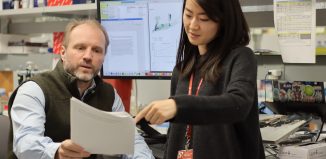Thomas Cubaud of SBU and microfluidics
Understanding the basic properties of mixing fluids
As a child in France, Thomas Cubaud grew up watching rivers, waves in the ocean, tides, and even the vortex that formed as bathwater ran down a drain.
Fast forward to now and the assistant professor at Stony Brook University has turned his passion for understanding the way fluids move and interact with each other into an award-winning developing career in mechanical engineering.
Cubaud works in a field called microfluidics. That means he mixes tiny amounts of different kinds of fluids (often very viscous or thick liquids with less viscous liquids or solvents). In addition to producing magnificent images, he also tries to understand the nature of the way these liquids mix.
Microfluidics is a relatively new science that was developed about 30 years ago. It has applications in a wide range of fields and helped produce such products as inkjet printheads, DNA chips, and microthermal technologies.
While aware of the potential applications of his research, Cubaud is much more focused on understanding the basic properties of mixing.
When researchers like Cubaud mix a very viscous liquid with a solvent in small amounts, they maximize the surface area (or points of contact) between the two liquids. While that could be an advantage in mixing, they also see what’s called laminar flow, where those two liquids form parallel layers and glide past each other, rather than mixing.
Enter viscous buckling. To picture this, take honey from a pantry and pour it on toast. As it comes out of a jar held a few inches above the toast, the honey falls in lines back and forth, looking like coiled rope. If the honey were falling through another thick liquid instead of air, the buckling back and forth would promote turbulent flow (converting the laminar flow — not good for mixing — into turbulent flow — much better for mixing).
One of the goals of Cubaud’s research is to understand the role of different properties, such as viscosity and surface tension, on the flow of fluids on a small scale.
In his experiments, Cubaud varies the speed at which he injects one fluid into another, the pressure and the thickness of the liquids.
Cubaud’s research showed sufficient promise that he recently won the Career Award from the National Science Foundation, which will give him $400,000 over a five-year period.
The award is given to promising young faculty members at universities around the country to support their teaching and research.
“The challenge is to find the best operating condition. We need to do experiments with different materials and new methods to characterize the flows,” he said.
Jon Longtin, an associate professor at Stony Brook and Cubaud’s mentor, sees considerable promise in his junior colleague.
“He is a genuine top-notch scholar,” Longtin said. “When he gets his arms around an idea, he wrestles it to the ground until he figures out exactly what is going on.”
Longtin said microfluidics has become a hot topic in science, which means there is increased competition for funding.
“He has carved out a niche for himself,” Longtin described. “He’s looking at fluids that have disparities in thickness. He found interesting things that happen that are not necessarily obvious. He’s had a lot of success.”
Cubaud’s research also examines a process called carbon sequestration, where carbon dioxide is removed from the air and absorbed into liquids.
“Injecting carbon dioxide gas with liquids in microgeometries permits us to significantly increase the surface area of contact between the fluids,” he said. “The knowledge that will be gained during the project will help frame future carbon sequestration applications.”
Cubaud pointed to a biological system that already uses microscale interactions between gases and liquids: the lungs, where blood gives up carbon dioxide and takes in oxygen.
Microfluidics allows scientists to achieve a basic understanding of new physical interactions, he said.
“A key aspect of miniaturization technology is that, up until recently, we could only observe phenomena,” he said. “Today, not only can we observe, but we can also directly intervene on small-scale mechanisms.”
Echoing the observations of the young boy in France who watched rivers, oceans and whirlpools in a bathtub, Cubaud said: “When you just do an experiment, you find unexpected results. It’s very exciting to see something possibly unexpected occurring.”






